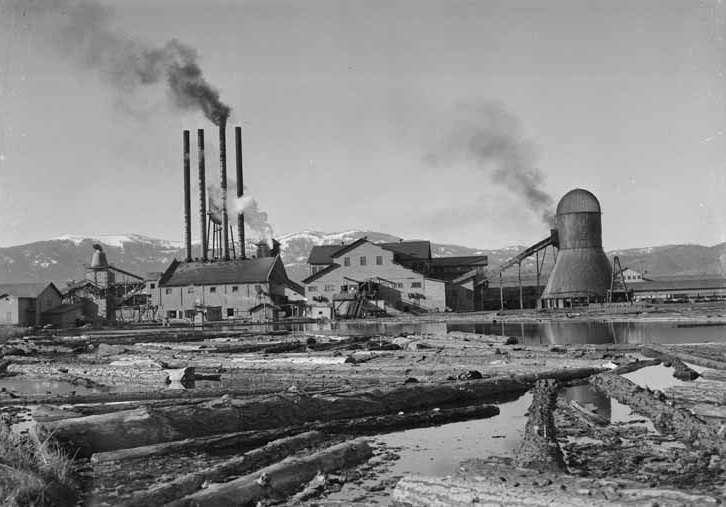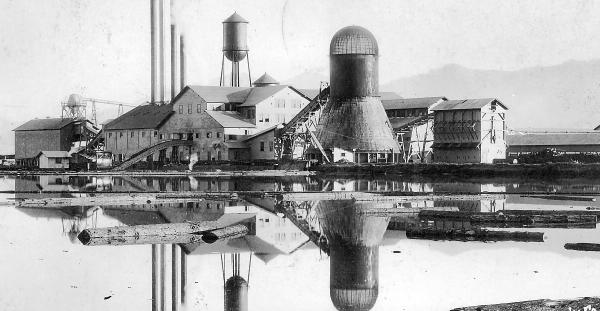I am sentimental about sawmills. That’s especially true around Christmas because the Sierra Pacific sawmill, at one time the second largest of its kind in the United States, was also the principal private employer where I was raised–in the sparsely populated northeastern corner of California.
My stepfather worked at Sierra Pacific for over twenty years, rolling logs in the millpond, pulling chain, freezing through graveyard shifts in the stacker house, and finally loading long lines of trucks and boxcars on a forklift. Like every man in that industry he worked like a Georgia mule, sometimes seven days a week, and never once did anyone hear him complain.
I often wonder what went through his mind on those long, very cold, and chaotic nights in the lumber mill, or the blistering hot summer days, when just about anyplace on earth probably felt like a better place to be. And I cherish memories of those mornings when, as I lay in my warm bed, he came home in the early dark, slipping into the house like a ghost. I would lie in bed and listen as he quietly stoked the woodstove in the living room, so that when we all got up for school the house would still be warm.

Future Houses
Throughout my childhood, our fortunes rose and fell with the vagaries of the timber industry. There were lean times, when my stepfather would bring home a notice on company letterhead from “Red” Emmerson—who had built his empire of lumber mills in northern California from the ground up—lamenting with enviable sincerity a series of layoffs.
And those days were made still leaner when the sawmill whistle, which blew every day at noon over the town of Susanville, went terribly and awkwardly silent, and we sat on my mother’s bed counting out nickels and pennies to pay for school pictures.
My step-dad would make up the difference by feeding out cattle for our neighbors. He would cross the creek below our place—we lived far out of town–on a slippery old 2×12, then walk up the hill to the hay yards where hungry cattle stood covered in ice and bawling, on mornings so cold he had to use a blowtorch to unlock the tractor tires where they had frozen to the ground.

Mural, Susanville, California
But even in those rougher times there was an abiding sense of local community that bound families together. There was no notion of an aristocracy in our county, no family who wasn’t touched directly or indirectly by the fortunes of the mill. We were all in it together, come what may, and we never went hungry.
None of that has ever left me. If anything, those days are so deeply ingrained that I can’t smell fresh-sawn lumber without thinking of my step-dad’s work clothes hanging in the laundry room, see his battered blue hardhat sitting on the dryer next to his worn-out old gloves, or see in my mind’s eye the towering decks of timber sitting in the summer sunlight, watered by sprinklers, waiting to be fed into the sawmill.
And there were good times, too. In this season of giving thanks, I am grateful for memories of the Mill Party, a Christmas bash for the sawmill men and their families when the lumber industry was humming, before it was sacrificed to know-it-alls in the special interest and political cabals, then crated up and shipped off-shore to support other families, in some other country, somewhere else in the world.
For the Mill Party—which to a young boy was the biggest single event of the holiday season–families would gather at the fairgrounds, hundreds of people in their modest Sunday best, and each child was called up to the front of the room by a huge man dressed as Santa Claus to receive a present.
Santa would draw your name out of a hat, or a box, or whatever it was, and you walked up there in front of everyone to embrace a gift that not only meant something about Christmas, but about what it meant to live in a community of people who knew what hard times really look like, knew how to spread the wealth when things were better, and worried fiercely about the future of an industry they had invested their lives, and the fortunes of their families, in seeing succeed.

She’s All Gone Now
And I can remember those years, which was most of them, when I would ask my parents when the Mill Party was, and they didn’t have an answer. As an adult I can see that silence for what it really was, and I am grateful for the strength and the grace they had to shield their children from the worries they carried in their chests like a hot, heavy stone.
The mill is gone now, mostly torn down to a rusty shell of its former self. It is the way of things. But I will never be able to pass that place between the train tracks and the Susan River without hearing the noon-whistle, or remembering that long walk down the aisle toward an exhausted lumber man dressed as Santa Claus, who handed me a present with a smile. And I know now that whatever it might have been when I was a small boy, a Tonka truck or a brace of silver six shooters, I will be unwrapping that gift for the rest of my life.


I’ve been spending a lot of time in the mill towns up here in Maine. I’ll sit in the town diner and eavesdrop on the next booth about the fire at the old mill or the old pictures they missed from the office walls or Ralph’s son moved to Arizona for work. Yours is a story that was told 10,000 times by these folks. But not nearly as eloquently. Thanks.
LikeLike
Ah yes, the great north woods. Check out Jeffrey Lent’s novels, you might like them. Some great stories about those early days in the northern woods of which you speak. Thanks Jim.
LikeLike
You are fortunate to have grown up where and when you did. Those are memories to cherish. Thanks for sharing.
LikeLike
Thank you, fine sir.
LikeLike
Thank you Craig. This one was particularly sweet. And, we remember a little guy running down the driveway looking at his shadow and thinking he was like Tony Dorset. In the evening, when the air cooled, Susanville smelled like freshly cut pine trees too.
LikeLiked by 1 person
Thank you Craig. This is a heartfelt description of a life in service to others (aka – loving parents). Struggling financially sucks, especially for parents who are just trying to cover the basics (I am talking food and shelter, not a cell-phone). It should also remind those quiet enough to listen – it’s not just about the $. I am thankful for the experience of my youth including the tough times and consider it a gift.
LikeLike
Thanks, TJ. The real challenge is to turn those times into a net positive. These days, I’m afraid, they are most often used as excuses to demand entitlements or to support a victim narrative.
LikeLike
Lovely piece, Craig.
the lumber industry was humming, before it was sacrificed to know-it-alls in the special interest and political cabals, then crated up and shipped off-shore to support other families, in some other country, somewhere else in the world.
Outsourcing has put such a heavy lien on America’s soul. I wonder if we can ever get it out of hock.
LikeLike
I wonder too–my suspicion is that we cannot–at least not without a massive cultural correction. Such an event would likely be catastrophic beyond belief. Of course, history suggests those catastrophic corrections are unavoidable in the long run. But I remain hopeful.
LikeLike
My grandfather Curt aka ‘Shrimp’ was youngest of 13 and the last one to be brought over from Europe in the 1890’s. His father had two Breweries, one in St. Paul, MN and the other in Bismark, SD, both burned down almost simultaneously, leaving the family with very little. They moved to Klamath Falls, OR. where Shrimp started working full time in the saw mill instead of entering the 5th grade, by 17 he was a foreman. He was a pioneer in the “Box Shook” industry, for those too young to remember, most food as many different goods were packaged and shipped in wood boxes.
Ultimately he ended up in Sacramento where his factory made Boxes, he had a mill in Greenville, CA. as you know not far from Susanville. Shrimp early on figured out how to get more product out of the logs, he got an extra ‘car load’ out of so many board feet than his competitors. His secret was as, the title of the book he wrote “Plane Thick Rip em Wide”, his book is in many University Forestry Department libraries. He also may have invented the first Fork Lift, that’s another story. He went to the plant before his kids were out of bed, many nights arriving home after they’d gone to bed. He was all about production and utilizing as much of the tree as possible. Anyhow, there is way more to this story which i will write about in the future when i do a Blog next year.
Thanks for the story, sure brought back some fond memories for me too, as i also grew up around saw mills and box factories.
Take care
Todd
LikeLike
This is fantastic Todd, thanks for sharing. I look forward to reading more about Shrimp. And I do know Greenville, fairly well. I wrestled in my first tournament there when I was six years old, and every year after until graduating high school. Greenville produced some very good native American wrestlers. Fascinating place, as is all of that country. I am ceaselessly amazed at these stories of people who kept chasing it down–in this case from europe to the great plains and finally Klamath Falls. Simply terrific, thanks again for posting it up here.
LikeLike
Craig
Contact me offline, I’ll provide more info with photos from early 1900’s.
Todd
LikeLike
http://www.rranch.org/index.php/about-r-ranch/history.html
A short history and some photos re the history of the Mount Whitney Logging Company and the town of “Johnsondale” (no relation), in the Sequoia National Forest, Tulare County Ca. In the late 30’s until it closed down in the 1970’s. At one point a town of 600-700 and self contained. It is now R-Ranch where we currently use the old cabins to stay in-between out door adventures. It was the home of Shoshonean-speaking Tubatulabal indians before that. Last Cali Grizzly killed nearby. Most of the buildings, tons of history and a few ghosts still remain.
LikeLike